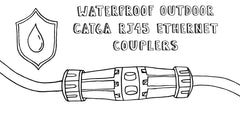Payment methods accepted

Using Fiber Optics to Extend Your Ethernet Network Beyond Copper's Limits
Written by Don Schultz, trueCABLE Senior Technical Advisor, Fluke Networks Copper/Fiber CCTT, BICSI INST1, INSTC, INSTF Certified
If you have been installing copper twisted pair Ethernet networks for some time you will no doubt have come across situations where the distance you need to go is too far for any single segment of the cable. An experienced installer knows to use Ethernet switches to extend connections and with the advent of PoE powered switches this even negates the need for an AC electrical outlet to power up the remote switch. There are situations where neither solution is feasible and this leads to a great deal of head scratching and anxiety.
In this blog we will discuss a situation that fits into the seemingly “impossible to get from point A to point B” category--an outdoor direct burial run that needs to go 500 feet between a home and barn. Oh, and it needs to achieve 10Gb/s as well, just to add to the pain. This is not an uncommon scenario. How in the heck do you get this done? Keep reading. Grab coffee.
trueCABLE and trueFIBER have officially merged. For more information, you can visit our Help Center for all the details.
Copper Ethernet cabling has distance limitations
It is common knowledge that Ethernet cable channels cannot exceed 328 feet. What is not so common knowledge is that the maximum number assumes an ambient temperature of 68°F and includes both solid copper bulk Ethernet cable and patch cables at either end, too. The basic formula is:
- Up to 295 feet (90 meters) of solid copper bulk Ethernet (22 to 24 AWG)
- Up to a total of 33 feet (10 meters) of stranded copper Ethernet patch cord (24 AWG)
- 328 feet (100 meters) total from powered device to powered device
That is the best you can achieve under the most ideal circumstances. If temperatures rise your cable runs actually get shorter. See Temperature's Effect on Ethernet Cable Length for a detailed chart that shows you how far you can go based on different ambient temperatures. You can mitigate higher temperatures to an extent by using shielded cable runs, but that just introduces another set of factors like:
- Increased costs for the cable and termination hardware
- Increased installation difficulty due to bend radius restrictions and much thicker cable
- Requirement for the cable shields to be properly bonded and grounded
In our home to barn scenario, you can be sure that your cable run will not be at 68°F for several months out of the year unless you live in the arctic. When planning run lengths for Ethernet cable, you have to take into account the worst case scenario upper ambient temperatures. Have you ever heard of a cable installation that works great right up until about noon on a hot summer day and then all of the sudden starts “acting up”? I have. The cable was at the maximum distance for 68°F and when ambient temperatures reached 85°F the run would not work reliably; speed was slow and the connection was intermittent.
It is a moot point anyway. You still cannot exceed that magic 328 feet even if you are using shielded Ethernet regardless of the environmental temperature. What to do?
One way to overcome copper distance limitations: More power and more copper
The traditional way of extending a network over a long run has been to use a remote switch. In this case, you are not actually defeating the length limitations. What you are doing is going around the issue by refreshing the signal with an intermediate powered device.


- This will get expensive. Each intermediate Ethernet switch is likely to be more than $100 each. These switches also need to be 10Gb/s, so good luck even finding an outdoor grade one. Most PoE powered outdoor switches operate at 2.5Gb/s or slower.
- You cannot (or at least should not) directly bury a PoE powered switch
- You cannot (unless you have an intermediate pole) suspend a PoE powered switch up in the air between two structures in an aerial run
- More terminations introduces more points of failure
- More Ethernet switches introduces more points of failure
- Ethernet surge protectors should be used at both ends of any copper inter-building run and those surge protectors have to be bonded to ground. See When Lightning Strikes! Ethernet Data Cable and Lightning Protection for more.
- The final gotcha is that shielded Ethernet cable needs to be used for aerial runs outdoors between structures. This introduces the possibility of ground loops. Read How To Fix a Ground Loop.
In other words, we have to think outside the box….because copper is not enough for this situation.
The better way to overcome copper distance limitations: Optical fiber
No doubt you have heard of “fiber.” Fiber, of course, is referring to fiber optic cable. Rather than relying upon electrons across copper wires, fiber uses pulses of light through incredibly thin glass or plastic. Here are the advantages to fiber optics:
- Operates much faster
- Operates over much longer distances
- Not susceptible to EMI/RFI/ESD
- No risk of ground loops
- Surge protection is not required for fiber optical cable
- Lighter and thinner
Of course, fiber optic has disadvantages otherwise everyone would be using it:
- If you don't buy pre-terminated fiber optic cabling, bulk unterminated fiber optic cable is difficult and costly to terminate properly
- Equipment required is not immediately familiar to many installers and might require some research. There might be a learning curve to understand new terms. Understanding the differences between Single Mode Fiber and Multimode Fiber may seem daunting. Concepts like transceivers and SFP/SFP+ come into play. This tends to scare people
- Fiber optic cannot support PoE, so fiber has much less utility in situations where the remote device must have data and power from the same cable
Optical fiber can enable 10GbE networking over long distances
Don’t let this new technology scare you. As it turns out, this new technology is not so new and has progressed into the consumer market. Prices have come down. Ease of use has improved dramatically. You don’t even have to terminate anything!
A single simple fiber run between two switches located in two different buildings is not difficult, nor expensive.
For a primer on fiber optic cable, please see Fiber Optic vs Copper UTP Enigma. This will give an excellent overview of the distance and speed advantages that fiber optic cable brings to the table.
For our example barn run, we will need the following:
- Fiber optic cable, already terminated. The length should be the 500 ft distance, plus the length needed for inside the structures, plus service slack.
- Two Ethernet switches or media converters that will allow you to plug in SFP+ transceivers and then transition to copper Ethernet from there
Shopping list:
- OM4 or higher multimode fiber optic cable, duplex, with LC connectors on both ends. This cable should be direct burial grade. Order your required length pre-terminated. You are good to 1,312 feet for 10G over OM4.
- Two SFP+ multimode transceivers, operating at 10G
- Two Ethernet switches/converters that can accept 10G SFP+ transceivers
The job of the transceiver is to convert electrons from the switch/converter into light pulses for transmission over the fiber cable and back again. The transceivers may be equipment specific, so only buy the transceivers the Ethernet switch/converter manufacturer recommends.
Ok, so we have talked about a lot of what this stuff looks like, but here are some pictures:

10G fiber media converter with SFP+ port and 10G copper Ethernet port.

10GBASE-SR multimode SFP+ transceiver.

OM4 duplex fiber patch cord with LC connectors. This is an indoor example.
Some notes on outdoor fiber installation
Let’s assume you have your pre-terminated fiber patch cable, transceivers, and media converters. The next step is installing it all.
- Place one media converter/switch in each structure
- The media converter shown above has a copper Ethernet port that supports NBASE-T so it can speed shift from 1 Gigabit through 10 Gigabit and also supports 2.5 and 5 Gigabit as well. Purchase the correct Category Ethernet patch cable to plug the converter into your conventional Ethernet switch. Cat6A is recommended for keeping it simple.
- Bury your fiber patch cable. Keep in mind the connectors are already attached and the worst thing is for them to get dirty. Triple wrap those connectors on both ends to make sure no dust, dirt, moisture or debris gets at them while running your cable. Don’t take off the end caps from the connectors until you are actually ready to plug them in!
- Plug it all in and you are done. You now have a reliable 10G outdoor buried fiber optic network backbone between two buildings!
So there you have it! Beyond learning a few new terms this was not that tough, was it? Keep in mind this is a simple single fiber run installation, designed and thought-through to be affordable. If you wish to have a more complex installation your equipment costs will dramatically increase. With that, I will say…
HAPPY NETWORKING!
trueCABLE presents the information on our website, including the “Cable Academy” blog and live chat support, as a service to our customers and other visitors to our website subject to our website terms and conditions. While the information on this website is about data networking and electrical issues, it is not professional advice and any reliance on such material is at your own risk.


































